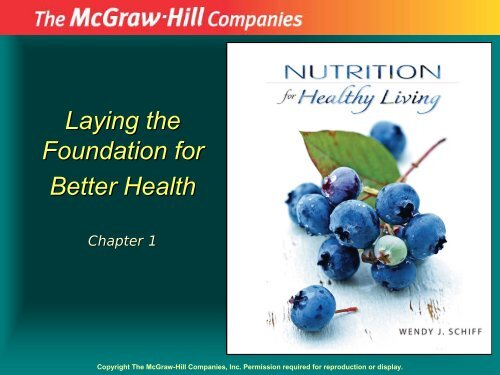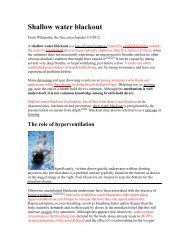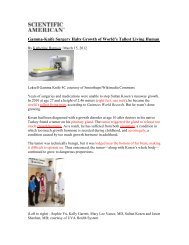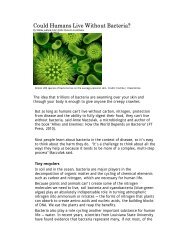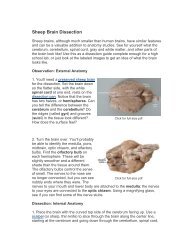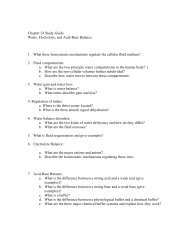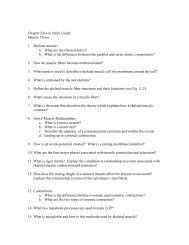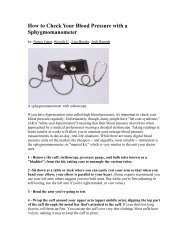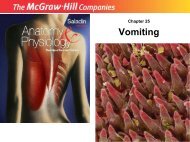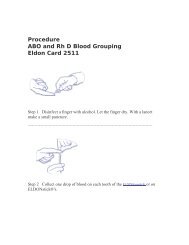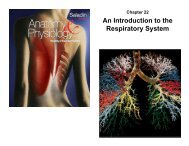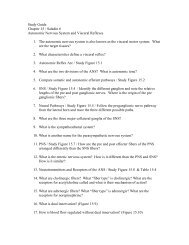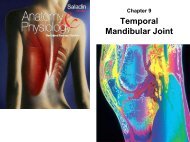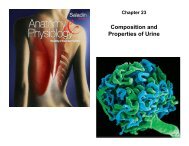Laying the Foundation for Better Health
Chapter 1 The Basics of Nutrition
Chapter 1 The Basics of Nutrition
- No tags were found...
Create successful ePaper yourself
Turn your PDF publications into a flip-book with our unique Google optimized e-Paper software.
<strong>Laying</strong> <strong>the</strong><br />
<strong>Foundation</strong> <strong>for</strong><br />
<strong>Better</strong> <strong>Health</strong><br />
Chapter 1<br />
Copyright The McGraw-Hill Companies, Inc. Permission required <strong>for</strong> reproduction or display.
My Teaching Philosophy<br />
(Summarized by These Three Quotations)<br />
• Nothing great was ever accomplished without<br />
enthusiasm. Henry David Thoreau<br />
• “To lead <strong>the</strong> people, walk behind <strong>the</strong>m,” “when <strong>the</strong><br />
best leader’s work is done, <strong>the</strong> people say, “We did it<br />
ourselves!” Lao-tze, Ancient Chinese Philosopher<br />
• Everything should be made as simple as possible, but<br />
not simpler. Albert Einstein
The Basics of Nutrition<br />
Nutrition<br />
The scientific study of nutrients, chemicals necessary<br />
<strong>for</strong> proper body functioning and how <strong>the</strong> body uses<br />
<strong>the</strong>m.<br />
Understanding nutrition also involves learning about<br />
human physiology, <strong>the</strong> study of how <strong>the</strong> body<br />
functions.<br />
Learning about foods and nutrients will provide you<br />
with in<strong>for</strong>mation you can use to make in<strong>for</strong>med<br />
decisions concerning <strong>the</strong> foods you eat. By making<br />
smart decisions about <strong>the</strong> foods you eat, you can<br />
improve your health and prevent chronic disease.<br />
• 70% eat whatever <strong>the</strong>y want<br />
• Poor eating habits are associated with 4 of <strong>the</strong> leading causes of death (heart<br />
disease, cancer, stroke, and type 2 diabetes).<br />
• Studies suggest 18% of American deaths could be eliminated by adopting<br />
“recommended dietary behaviors”.
•Family<br />
What<br />
Influences<br />
Your Eating<br />
Habits?<br />
•Childhood Experience<br />
• Ethnic Background<br />
• Education<br />
• Occupation<br />
• Income<br />
• Rural vs Urban Residence<br />
• Food Composition / Convenience<br />
• Flavor / Texture / Appearance<br />
• Religious Beliefs<br />
• Nutritional Beliefs<br />
• <strong>Health</strong> Status<br />
• Advertising<br />
• Moods<br />
• Availability
Nutrition<br />
Nutrition / Key Terms<br />
Scientific study of nutrients, <strong>the</strong> chemicals in<br />
food that are necessary <strong>for</strong> life, and how <strong>the</strong><br />
body uses <strong>the</strong>m<br />
Nutrients<br />
Diet<br />
Life-sustaining substances in food<br />
Typical pattern of food choices
Nutrition / Key Terms<br />
Chemistry<br />
Study of <strong>the</strong> composition and characteristics of<br />
matter and <strong>the</strong> changes that can occur to it<br />
Cell<br />
Smallest functioning structural unit in a living<br />
organism
Major Constituents of Cell
Plasma Membrane
General Cell Structure
Plasma Membrane
Why Should You Care About Your Diet?<br />
• Poor diet is associated with 4 of 10 leading causes<br />
of death:<br />
-Heart disease<br />
-Some types of cancer<br />
-Stroke<br />
-Type 2 diabetes<br />
• Adequate diet plus regular exercise may reduce<br />
your chances of developing <strong>the</strong>se serious chronic<br />
diseases.<br />
• Good nutrition is all about making smart choices!
Six Classes of Nutrients<br />
1. Carbohydrates<br />
2. Lipids (includes fat)<br />
3. Proteins<br />
4. Vitamins<br />
5. Minerals<br />
6. Water<br />
Food is a “mixture of nutrients”.<br />
• Eight fluid ounce serving of fat-free milk is about 91%<br />
water by weight. But it also contains carbohydrates,<br />
proteins, vitamins, and minerals.
Six Classes of Nutrients<br />
How much of each nutrient do you need to<br />
consume daily?<br />
1. Carbohydrate (125g – 200g daily)*<br />
2. Lipids (100g/day)<br />
3. Proteins (60g/day)<br />
4. Minerals (3.3 g/day)<br />
5. Vitamins (60 mg/day)<br />
6. Water (2.5 liters/day)<br />
* Note: Brain requires 120g/day
Note approximate<br />
percentages of<br />
nutrients in young<br />
male and female<br />
bodies.<br />
• Insert Figure 1.2<br />
Vitamins are not<br />
included, because<br />
<strong>the</strong>y are in very small<br />
amounts.
Major Functions of Nutrients<br />
in <strong>the</strong> Body<br />
Insert Table 1.1
Essential<br />
Nutrients<br />
Insert table 1.2<br />
Essential Nutrients<br />
-must be supplied<br />
by food<br />
-<strong>the</strong> body cannot<br />
syn<strong>the</strong>size or make<br />
enough of <strong>the</strong>m
Three Features of<br />
Essential Nutrients<br />
1. If missing from diet, a nutrient deficiency<br />
disease occurs.<br />
2. Adding missing nutrient back to diet corrects<br />
signs and symptoms of <strong>the</strong> deficiency.<br />
3. Scientists can explain why lack of <strong>the</strong> nutrient<br />
caused abnormalities.
Nonnutrients / Key Terms<br />
Fiber<br />
• Group of substances made by plants that<br />
humans do not digest<br />
• But produce some health benefits<br />
Phytochemicals<br />
• Compounds made by plants that are not<br />
nutrients<br />
• May be beneficial or toxic
Nonnutrients / Key Terms<br />
Antioxidants<br />
Substances that protect o<strong>the</strong>r compounds<br />
from being damaged or destroyed by certain<br />
environmental factors
Phytochemicals of Scientific Interest<br />
Insert table 1.3
What Are Dietary Supplements?<br />
Dietary supplements<br />
include:<br />
- Nutrient preparations<br />
- Certain hormones<br />
- Herbs<br />
FDA<br />
– Does not regulate dietary supplements as it regulates medications<br />
– Does en<strong>for</strong>ce purity standards<br />
– Does not “police” promotional statements” by manufacturer<br />
Echinacea Flower—<br />
<strong>the</strong> herbal supplement<br />
Echinacea is generally<br />
not useful <strong>for</strong> preventing<br />
or treating colds.
Factors that Influence Your <strong>Health</strong><br />
Your Lifestyle<br />
The way you live<br />
Your Risk Factors<br />
Personal characteristics<br />
that influence chances<br />
of developing disease<br />
Example:<br />
Lifestyle<br />
<br />
Poor diet and lack of regular<br />
exercise<br />
(Leads To)<br />
Excess Body Fat<br />
(Risk Factor)
Our Changing Eating Habits<br />
Insert Table 1.4<br />
Today, <strong>the</strong> typical American consumes more<br />
food energy, fat, and sugar than in 1970.
<strong>Health</strong>y People 2010<br />
A report from <strong>the</strong><br />
U.S. Public<br />
<strong>Health</strong> Service<br />
that includes 467<br />
specific national<br />
health promotion<br />
and disease<br />
prevention<br />
objectives<br />
Insert table 1.5
Metrics <strong>for</strong> Nutrition<br />
Units of scientific measurement often used<br />
in nutrition<br />
Length — meters<br />
Weight — grams<br />
Volume — liters
Metrics <strong>for</strong> Nutrition<br />
Metric Basics (approximations)<br />
1 inch = 2.5 cm<br />
1 ounce = 28 g<br />
1 pound = 454 g<br />
2.2 pounds = 1 kg<br />
Do <strong>the</strong> Math<br />
<br />
If you are 5’5” (65”)<br />
(65 x 2.5 = 162.5 cm)<br />
If you weigh 130 lbs<br />
(130 ÷ 2.2 = approx. 59<br />
kg)
Metrics <strong>for</strong> Nutrition<br />
What’s s a Calorie?<br />
calorie<br />
– measure of food energy<br />
– heat needed to raise 1 g of water 1 o Celsius<br />
Kilocalorie or Calorie<br />
– measure of food energy<br />
– Technically a kilocalorie is <strong>the</strong> heat energy needed to raise <strong>the</strong><br />
temperature of 1000 g (1 liter) of water 1 o Celsius.<br />
Specific number of calories in food is reported as kilocalories or Calories<br />
1 kilocalorie = 1000 calories = 1 Calorie
Kilocalorie Contributors in Diets<br />
• 1 g of carbohydrate provides 4 kcal.<br />
• 1 g of protein provides 4 kcal.<br />
• 1 g of fat provides 9 kcal.<br />
• 1 g pure alcohol (a non nutrient) provides<br />
7 kcal.
Macronutrients and Micronutrients<br />
Macronutrients<br />
Needed in gram<br />
amounts and provide<br />
energy<br />
• Carbohydrates,<br />
protein, and fat<br />
Micronutrients<br />
Needed in very small<br />
amounts and do not<br />
provide energy<br />
• Vitamins and<br />
minerals
• Average American<br />
~16% kcal (~20<br />
tsp) from added<br />
sugars<br />
• Dietary Guidelines<br />
recommend<br />
limiting added<br />
sugar intake to 4<br />
tsp/day <strong>for</strong> 2000<br />
kcal diet.
Key Basic<br />
Nutrition<br />
Concepts Insert Table 1.7
Concept 1: Most Naturally Occurring Foods<br />
are Mixtures of Nutrients.<br />
A 6 oz potato contains:<br />
4 g protein<br />
36 g carbohydrate<br />
Energy and Nutrient Composition<br />
Bread – Milk – Potato - Candy<br />
These foods contribute very<br />
different amounts of energy,<br />
water, protein, carbohydrate, fat,<br />
and calcium to diets.
Concept 2:<br />
Eating a variety of foods can help ensure <strong>the</strong><br />
nutritional adequacy of a diet.<br />
• There are no “perfect” natural foods that<br />
contain all nutrients in amounts needed<br />
by <strong>the</strong> human body.<br />
• Eat a variety of foods, especially fruits,<br />
vegetables, and minimally processed<br />
grains, to ensure nutritional adequacy.
There are no “good” or<br />
Concept 3: There are no<br />
“bad” foods.<br />
foods. (But some are better than o<strong>the</strong>rs)<br />
Empty Calorie versus Nutrient Dense<br />
<br />
<br />
Poor source of micronutrients<br />
(vitamins and<br />
minerals) compared to<br />
calories<br />
Has more micronutrients<br />
(vitamins and minerals) in<br />
relation to its energy<br />
value<br />
Note: Try to avoid energy dense foods.
Concept 4: Enjoy eating all food in moderation<br />
Dietary moderation =<br />
Obtaining enough nutrients from food<br />
+<br />
Avoiding excessive amounts of nutrients<br />
+<br />
Balancing calorie intake with expenditure
Concept: 5 For each nutrient, <strong>the</strong>re is<br />
a range of safe intakes.<br />
• Insert<br />
Figure<br />
1.7<br />
Physiological dose<br />
Amount of a nutrient within <strong>the</strong><br />
range of safe intake that enables<br />
<strong>the</strong> body to function optimally<br />
Megadose<br />
Generally defined as 10 times <strong>the</strong><br />
recommended amount of a vitamin<br />
or mineral
Concept 6: Food is <strong>the</strong> best source of nutrients<br />
and phytochemicals.<br />
During refinement, a wheat kernel is stripped of <strong>the</strong> nutrient-rich germ and<br />
photochemical-rich bran. Only <strong>the</strong> endoderm is saved as <strong>the</strong> “white flour”.
Concept 7: There is no “One Size Fits All” approach to<br />
planning a nutritionally adequate diet.<br />
Food guides can be<br />
used to individualize<br />
your diet, so it is<br />
nutritionally adequate<br />
and suits your likes and<br />
dislikes.
Concept 8:<br />
Foods and <strong>the</strong> nutrients <strong>the</strong>y contain are not cure-alls.<br />
Specific nutrient deficiency diseases can be<br />
cured by eating foods that contain <strong>the</strong><br />
missing nutrient.<br />
But, nutrients do not “cure” o<strong>the</strong>r ailments.
Malnutrition includes<br />
UNDERnutrition as well as OVERnutrition<br />
Concept 9: Malnutrition includes<br />
Malnutrition<br />
State of health that occurs when <strong>the</strong> body is<br />
improperly nourished<br />
May be from inadequate or excessive<br />
amounts of nutrients
Concept 10: Nutrition is a dynamic science.<br />
• As researchers continue to explore<br />
complex relationships between diets<br />
and health, nutrition in<strong>for</strong>mation<br />
constantly evolves.<br />
• Even nutrition educators have difficulty<br />
keeping up with <strong>the</strong> vast amount of<br />
research published in scientific journals.
Chapter 1 Highlight<br />
Malnutrition: A Worldwide Concern<br />
• Malnutrition<br />
– Improper nourishment<br />
• Chronic undernutrition<br />
– Long-term energy and nutrient deficiency<br />
• Hunger<br />
- In children: stunted growth, delayed physical<br />
development, blindness, impaired intellectual<br />
development, and premature death<br />
– Physiological need <strong>for</strong> food
Factors that Contribute to Undernutrition<br />
• Insert figure 1.A
Undernutrition<br />
• Affects ~ 1 in 3 people<br />
worldwide<br />
• Insert figure 1.B<br />
• More prevalent in:<br />
- Children<br />
- Underdeveloped countries
Under Nutrition During Life Cycle Stages<br />
The worst time <strong>for</strong> under nutrition to occur is during <strong>the</strong> stage of<br />
rapid development and growth.<br />
- Pregnancy<br />
- Infancy<br />
- Preschool years
Effects of Malnutrition on Children<br />
Chronically undernourished children are<br />
underweight, do not grow normally, and tend<br />
to be shorter—if <strong>the</strong>y survive to adulthood—<br />
than properly nourished children.<br />
A child’s nutritional related developmental<br />
problems , including brain function, can not be<br />
reversed as an adult with an improved diet.<br />
The damage has already been done!
Undernutrition in <strong>the</strong> United States<br />
Contributing factors:<br />
- Anorexia nervosa<br />
- Alcoholism<br />
- Low income<br />
Food insecurity:<br />
-Reported in 11% of U.S. households
Major U.S. Food Assistance Programs<br />
• Food Stamp Program<br />
• Commodity Supplemental Food Program<br />
• Special Supplemental Nutrition Program <strong>for</strong> Women, Infants, and Children.<br />
• National School Lunch Program<br />
• School Breakfast Program<br />
• Child and Adult Care Food Program<br />
• The Elderly Nutrition Program Congregate Meals <strong>for</strong> Elderly<br />
• Home-Delivered Meals (Meals on Wheels)<br />
• Food Distribution Program on Indian Reservations.
Solutions<br />
Biotechnology<br />
Modifying living things<br />
(especially plants and<br />
animals) to make improved<br />
products<br />
Insert Figure 1.F<br />
Genetic Modification<br />
Techniques that alter an<br />
organism’s s DNA
End of Lecture
Chapter Learning Outcomes<br />
1. Define terms such as diet, nutrition, nutrient,<br />
essential nutrient, macronutrient, micronutrient,<br />
kilocalorie, and photochemical.<br />
2. Identify factors that influence personal food<br />
choices.<br />
3. Identify lifestyle factors that contribute to <strong>the</strong><br />
leading causes of death in <strong>the</strong> United States.<br />
4. List <strong>the</strong> 6 classes of nutrients and identify a<br />
major role of each class in <strong>the</strong> body.<br />
5. Identify basic metric system units often used in<br />
nutrition.
Chapter Learning Outcomes<br />
(continued)<br />
6. Explain <strong>the</strong> concept of energy density and identify<br />
energy-dense foods.<br />
7. Use <strong>the</strong> caloric values of energy-yielding yielding nutrients to<br />
estimate <strong>the</strong> amount of energy in a food.<br />
8. Identify key basic nutrition concepts, such as <strong>the</strong><br />
importance of eating a variety of foods and no food<br />
supplies all nutrients.<br />
9. Discuss factors that contribute to malnutrition in <strong>the</strong><br />
world.<br />
10. Identify major federal U.S. food assistance programs.
Quiz Yourself<br />
True or False<br />
1. There are four classes of nutrients: proteins,<br />
lipids, sugars, and vitamins. T F<br />
2. Proteins are <strong>the</strong> most essential class of<br />
nutrients. T F<br />
3. All nutrients must be supplied by <strong>the</strong> diet,<br />
because <strong>the</strong>y cannot be made by <strong>the</strong> body.<br />
T F<br />
4. Vitamins are a source of energy. T F<br />
5. Milk, carrots, and bananas are examples of<br />
“perfect foods” that contain all nutrients.<br />
T F
How Did You Do?<br />
1. False There are six classes of nutrients:<br />
carbohydrates, lipids, proteins, vitamins,<br />
minerals, and water.<br />
2. False Proteins are not <strong>the</strong> most essential<br />
class of nutrients.<br />
3. False All nutrients do not need to be<br />
supplied by <strong>the</strong> diet, because some can be<br />
made by <strong>the</strong> body.<br />
4. False Vitamins are not a source of energy.<br />
5. False Milk, carrots, and bananas are not<br />
“perfect foods.” No naturally-occurring food<br />
supplies all nutrients.


